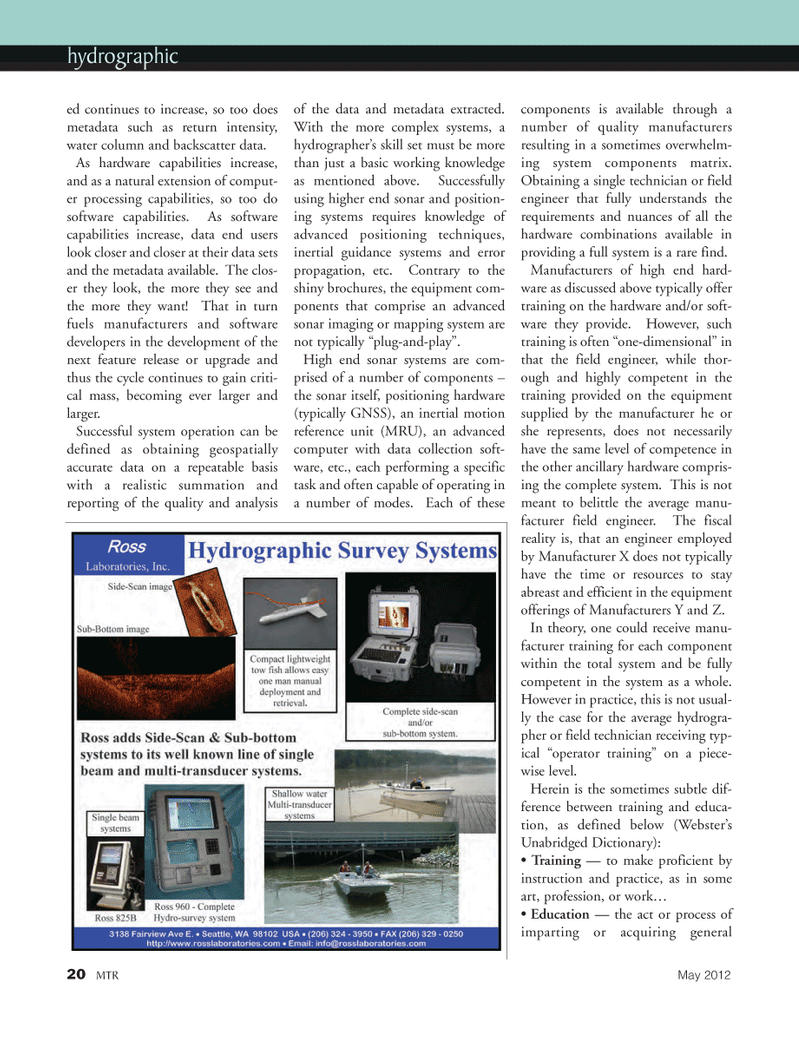
Page 20: of Marine Technology Magazine (May 2012)
Hydrographic Survey
Read this page in Pdf, Flash or Html5 edition of May 2012 Marine Technology Magazine
20MTRMay 2012ed continues to increase, so too does metadata such as return intensity, water column and backscatter data. As hardware capabilities increase, and as a natural extension of comput-er processing capabilities, so too do software capabilities. As software capabilities increase, data end users look closer and closer at their data setsand the metadata available. The clos- er they look, the more they see and the more they want! That in turn fuels manufacturers and software developers in the development of the next feature release or upgrade and thus the cycle continues to gain criti- cal mass, becoming ever larger and larger. Successful system operation can be defined as obtaining geospatiallyaccurate data on a repeatable basis with a realistic summation and reporting of the quality and analysis of the data and metadata extracted.With the more complex systems, a hydrographer?s skill set must be more than just a basic working knowledge as mentioned above. Successfully using higher end sonar and position-ing systems requires knowledge of advanced positioning techniques, inertial guidance systems and error propagation, etc. Contrary to the shiny brochures, the equipment com- ponents that comprise an advanced sonar imaging or mapping system are not typically ?plug-and-play?. High end sonar systems are com- prised of a number of components ?the sonar itself, positioning hardware (typically GNSS), an inertial motion reference unit (MRU), an advanced computer with data collection soft-ware, etc., each performing a specific task and often capable of operating ina number of modes. Each of thesecomponents is available through a number of quality manufacturers resulting in a sometimes overwhelm- ing system components matrix.Obtaining a single technician or field engineer that fully understands therequirements and nuances of all the hardware combinations available in providing a full system is a rare find. Manufacturers of high end hard- ware as discussed above typically offer training on the hardware and/or soft- ware they provide. However, such training is often ?one-dimensional? in that the field engineer, while thor- ough and highly competent in thetraining provided on the equipment supplied by the manufacturer he or she represents, does not necessarily have the same level of competence in the other ancillary hardware compris- ing the complete system. This is not meant to belittle the average manu- facturer field engineer. The fiscal reality is, that an engineer employed by Manufacturer X does not typically have the time or resources to stay abreast and efficient in the equipment offerings of Manufacturers Y and Z. In theory, one could receive manu- facturer training for each component within the total system and be fullycompetent in the system as a whole.However in practice, this is not usual- ly the case for the average hydrogra- pher or field technician receiving typ- ical ?operator training? on a piece- wise level. Herein is the sometimes subtle dif- ference between training and educa- tion, as defined below (Webster?s Unabridged Dictionary): Training ? to make proficient by instruction and practice, as in some art, profession, or work? Education ? the act or process of imparting or acquiring general hydrographic MTR#4 (18-33):MTR Layouts 5/4/2012 2:32 PM Page 20

 19
19

 21
21
